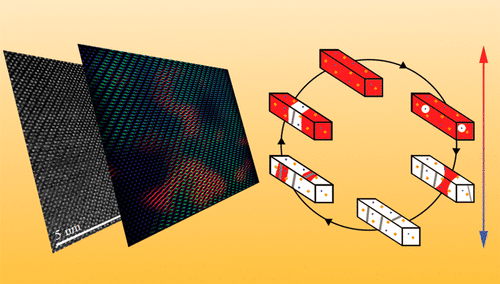当前位置:
X-MOL 学术
›
Chem. Mater.
›
论文详情
Our official English website, www.x-mol.net, welcomes your
feedback! (Note: you will need to create a separate account there.)
Modulating the Hysteresis of an Electronic Transition: Launching Alternative Transformation Pathways in the Metal–Insulator Transition of Vanadium(IV) Oxide
Chemistry of Materials ( IF 7.2 ) Pub Date : 2017-12-20 00:00:00 , DOI: 10.1021/acs.chemmater.7b04203 Erick J. Braham , Diane Sellers , Emily Emmons , Ruben Villarreal , Hasti Asayesh-Ardakani 1 , Nathan A. Fleer , Katie E. Farley , Reza Shahbazian-Yassar 1 , Raymundo Arròyave , Patrick J. Shamberger , Sarbajit Banerjee
Chemistry of Materials ( IF 7.2 ) Pub Date : 2017-12-20 00:00:00 , DOI: 10.1021/acs.chemmater.7b04203 Erick J. Braham , Diane Sellers , Emily Emmons , Ruben Villarreal , Hasti Asayesh-Ardakani 1 , Nathan A. Fleer , Katie E. Farley , Reza Shahbazian-Yassar 1 , Raymundo Arròyave , Patrick J. Shamberger , Sarbajit Banerjee
Affiliation

|
Materials exhibiting pronounced metal–insulator transitions such as VO2 have acquired great importance as potential computing vectors and electromagnetic cloaking elements given the large accompanying reversible modulation of properties such as electrical conductance and optical transmittance. As a first-order phase transition, considerable phase coexistence and hysteresis is typically observed between the heating insulator → metal and cooling metal → insulator transformations of VO2. Here, we illustrate that substitutional incorporation of tungsten greatly modifies the hysteresis of VO2, both increasing the hysteresis as well as introducing a distinctive kinetic asymmetry wherein the heating symmetry-raising transition is observed to happen much faster as compared to the cooling symmetry-lowering transition, which shows a pronounced rate dependence of the transition temperature. This observed kinetic asymmetry upon tungsten doping is attributed to the introduction of phase boundaries resulting from stabilization of nanoscopic M2 domains at the interface of the monoclinic M1 and tetragonal phases. In contrast, the reverse cooling transition is mediated by point defects, giving rise to a pronounced size dependence of the hysteresis. Mechanistic elucidation of the influence of dopant incorporation on hysteresis provides a means to rationally modulate the hysteretic width and kinetic asymmetry, suggesting a remarkable programmable means of altering hysteretic widths of an electronic phase transition.
中文翻译:

调节电子跃迁的磁滞现象:在氧化钒(IV)的金属-绝缘体跃迁中启动其他跃迁途径
表现出明显的金属-绝缘体转变的材料(例如VO 2)作为潜在的计算载体和电磁隐身元素,已经获得了巨大的重视,因为伴随而来的是诸如电导率和光透射率之类的性质的可逆调制。作为一阶相变,通常在VO 2的加热绝缘体→金属和冷却金属→绝缘体转变之间观察到相当大的相共存和磁滞现象。在这里,我们说明钨的取代掺入极大地改变了VO 2的磁滞,既增加了磁滞,又引入了独特的动力学不对称性,其中观察到加热对称性升高的转变比冷却对称性降低的转变要快得多,这表明了转变温度的明显速率依赖性。钨掺杂时观察到的动力学不对称性归因于由于单斜M 1界面处的纳米M 2结构域稳定而引入的相界。和四方相。相反,反向冷却转变是由点缺陷所介导的,引起了明显的磁滞尺寸依赖性。对掺杂物掺入对磁滞的影响的机理的阐明为合理调节磁滞宽度和动力学不对称性提供了一种手段,表明改变电子相变的磁滞宽度的一种显着的可编程手段。
更新日期:2017-12-20
中文翻译:

调节电子跃迁的磁滞现象:在氧化钒(IV)的金属-绝缘体跃迁中启动其他跃迁途径
表现出明显的金属-绝缘体转变的材料(例如VO 2)作为潜在的计算载体和电磁隐身元素,已经获得了巨大的重视,因为伴随而来的是诸如电导率和光透射率之类的性质的可逆调制。作为一阶相变,通常在VO 2的加热绝缘体→金属和冷却金属→绝缘体转变之间观察到相当大的相共存和磁滞现象。在这里,我们说明钨的取代掺入极大地改变了VO 2的磁滞,既增加了磁滞,又引入了独特的动力学不对称性,其中观察到加热对称性升高的转变比冷却对称性降低的转变要快得多,这表明了转变温度的明显速率依赖性。钨掺杂时观察到的动力学不对称性归因于由于单斜M 1界面处的纳米M 2结构域稳定而引入的相界。和四方相。相反,反向冷却转变是由点缺陷所介导的,引起了明显的磁滞尺寸依赖性。对掺杂物掺入对磁滞的影响的机理的阐明为合理调节磁滞宽度和动力学不对称性提供了一种手段,表明改变电子相变的磁滞宽度的一种显着的可编程手段。











































 京公网安备 11010802027423号
京公网安备 11010802027423号